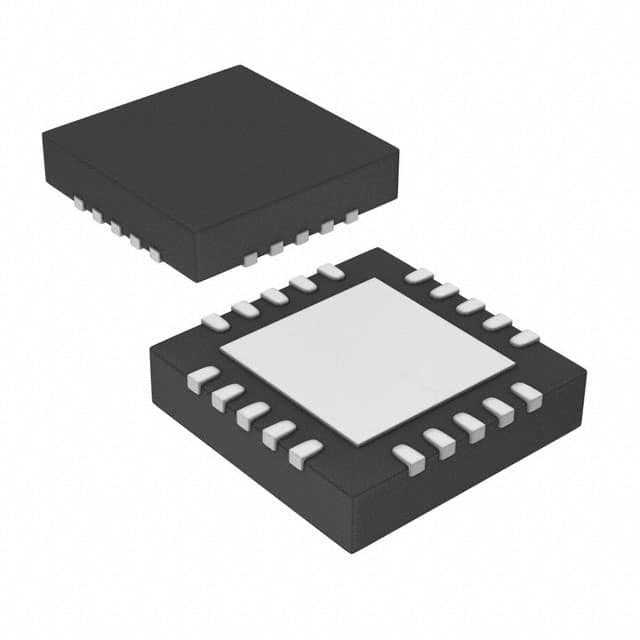Consulte las especificaciones para obtener detalles del producto.

PIC16F685T-I/ML
Product Overview
Category
The PIC16F685T-I/ML belongs to the category of microcontrollers.
Use
This microcontroller is commonly used in various electronic applications that require embedded control and processing capabilities.
Characteristics
- High-performance 8-bit RISC architecture
- Flash program memory
- Low power consumption
- Wide operating voltage range
- Enhanced peripheral integration
- Small form factor
Package
The PIC16F685T-I/ML is available in a small outline, surface mount package (ML) with a total of 28 pins.
Essence
The essence of this microcontroller lies in its ability to provide efficient and reliable control and processing capabilities in a compact package.
Packaging/Quantity
The PIC16F685T-I/ML is typically packaged in reels or tubes, with a quantity of 250 units per reel/tube.
Specifications
- CPU Speed: Up to 20 MHz
- Program Memory Size: 7 KB
- RAM Size: 256 bytes
- Number of I/O Pins: 22
- ADC Channels: 12
- Timers: 3
- Communication Interfaces: SPI, I2C, UART
Detailed Pin Configuration
The PIC16F685T-I/ML features a total of 28 pins, each serving a specific purpose. The pin configuration is as follows:
- VDD - Power supply voltage
- RA0/AN0 - Analog input channel 0 / Digital I/O pin
- RA1/AN1 - Analog input channel 1 / Digital I/O pin
- RA2/AN2 - Analog input channel 2 / Digital I/O pin
- RA3/AN3 - Analog input channel 3 / Digital I/O pin
- RA4/T0CKI/C1OUT - Timer0 clock input / Digital I/O pin / Comparator output
- RA5/AN4/SS/C2OUT - Analog input channel 4 / Slave select for SPI / Digital I/O pin / Comparator output
- RE0/RD/AN5 - Port E, bit 0 / Read/Write control signal / Analog input channel 5
- RE1/WR/AN6 - Port E, bit 1 / Write control signal / Analog input channel 6
- RE2/CS/AN7 - Port E, bit 2 / Chip select for SPI / Analog input channel 7
- VSS - Ground
- OSC1/CLKIN - Oscillator crystal input
- OSC2/CLKOUT - Oscillator crystal output
- RC0/T1OSO/T1CKI - Timer1 oscillator output / Timer1 clock input
- RC1/T1OSI/CCP2 - Timer1 oscillator input / Capture/Compare/PWM module 2
- RC2/CCP1 - Capture/Compare/PWM module 1
- RC3/SCL - I2C serial clock line
- RC4/SDA - I2C serial data line
- RC5/SDO - SPI serial data output
- RC6/TX/CK - USART transmit data / USART synchronous clock
- RC7/RX/DT - USART receive data / USART asynchronous clock
- RB0/INT - External interrupt input
- RB1 - Digital I/O pin
- RB2 - Digital I/O pin
- RB3 - Digital I/O pin
- RB4 - Digital I/O pin
- RB5 - Digital I/O pin
- MCLR/VPP - Master Clear input / Programming voltage supply
Functional Features
The PIC16F685T-I/ML offers a range of functional features that enhance its performance and versatility. Some notable features include:
- Flash program memory for easy reprogramming
- Enhanced peripheral integration, including timers, ADC channels, and communication interfaces
- Low power consumption for energy-efficient applications
- Wide operating voltage range for flexibility in various power supply scenarios
- High-performance 8-bit RISC architecture for efficient processing
Advantages and Disadvantages
Advantages
- Compact size and small form factor
- Efficient control and processing capabilities
- Enhanced peripheral integration
- Low power consumption
- Wide operating voltage range
Disadvantages
- Limited program memory size (7 KB)
- Limited RAM size (256 bytes)
- Limited number of I/O pins (22)
Working Principles
The PIC16F685T-I/ML operates based on the principles of an 8-bit RISC architecture. It executes instructions stored in its flash program memory to perform various tasks. The microcontroller interacts with external devices through its I/O pins and utilizes its integrated peripherals to carry out functions such as timing, analog
Enumere 10 preguntas y respuestas comunes relacionadas con la aplicación de PIC16F685T-I/ML en soluciones técnicas
What is the maximum operating frequency of PIC16F685T-I/ML?
- The maximum operating frequency of PIC16F685T-I/ML is 20 MHz.Can PIC16F685T-I/ML be used for battery-powered applications?
- Yes, PIC16F685T-I/ML is suitable for battery-powered applications due to its low power consumption.What are the communication interfaces supported by PIC16F685T-I/ML?
- PIC16F685T-I/ML supports SPI and I2C communication interfaces.Is PIC16F685T-I/ML suitable for motor control applications?
- Yes, PIC16F685T-I/ML can be used for simple motor control applications.What are the available memory options in PIC16F685T-I/ML?
- PIC16F685T-I/ML has 3.5 KB of Flash program memory and 256 bytes of RAM.Can PIC16F685T-I/ML be programmed using C language?
- Yes, PIC16F685T-I/ML can be programmed using the C language with appropriate compilers.Does PIC16F685T-I/ML have built-in analog-to-digital converters (ADC)?
- Yes, PIC16F685T-I/ML features a 10-bit ADC with multiple channels.What are the available package options for PIC16F685T-I/ML?
- PIC16F685T-I/ML is available in a 20-pin QFN package.Can PIC16F685T-I/ML operate in harsh industrial environments?
- Yes, PIC16F685T-I/ML is designed to operate in harsh industrial environments with proper precautions.Are there any development boards or evaluation kits available for PIC16F685T-I/ML?
- Yes, there are development boards and evaluation kits specifically designed for PIC16F685T-I/ML to aid in prototyping and testing.

